
A | B | C | D | E | F | G | H | CH | I | J | K | L | M | N | O | P | Q | R | S | T | U | V | W | X | Y | Z | 0 | 1 | 2 | 3 | 4 | 5 | 6 | 7 | 8 | 9
This article may be too long to read and navigate comfortably. When this tag was added, its readable prose size was 13,950 words. (March 2024) |
Great Qing | |||||||||||||||||||||
|---|---|---|---|---|---|---|---|---|---|---|---|---|---|---|---|---|---|---|---|---|---|
| 1644[1][2]–1912 | |||||||||||||||||||||
|
Flag (1889–1912) | |||||||||||||||||||||
Anthem:
| |||||||||||||||||||||
| Imperial seal: 大清帝國之璽  | |||||||||||||||||||||
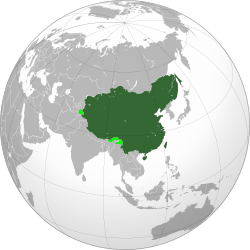 The Qing dynasty at its greatest extent in 1760, with modern borders shown. Claimed territory that was not under its control is shown in light green. | |||||||||||||||||||||
| Capital | |||||||||||||||||||||
| Largest city | Beijing | ||||||||||||||||||||
| Official languages | |||||||||||||||||||||
| Ethnic groups | |||||||||||||||||||||
| Religion | |||||||||||||||||||||
| Demonym(s) | Chinese | ||||||||||||||||||||
| Government | Absolute monarchy[c] | ||||||||||||||||||||
| Emperor | |||||||||||||||||||||
• 1636–1643 (proclaimed in Shenyang) | Chongde Emperor | ||||||||||||||||||||
• 1644–1661 (first in Beijing) | Shunzhi Emperor | ||||||||||||||||||||
• 1908–1912 (last) | Xuantong Emperor | ||||||||||||||||||||
| Regent | |||||||||||||||||||||
• 1643–1650 | Dorgon, Prince Rui | ||||||||||||||||||||
• 1908–1911 | Zaifeng, Prince Chun | ||||||||||||||||||||
| Prime Minister | |||||||||||||||||||||
• 1911 | Yikuang, Prince Qing | ||||||||||||||||||||
• 1911–1912 | Yuan Shikai | ||||||||||||||||||||
| Legislature |
| ||||||||||||||||||||
| Historical era | Late modern | ||||||||||||||||||||
| 1636 | |||||||||||||||||||||
| 1644–1662 | |||||||||||||||||||||
| 1687–1758 | |||||||||||||||||||||
| 1747–1792 | |||||||||||||||||||||
| 1839–1842 | |||||||||||||||||||||
| 1850–1864 | |||||||||||||||||||||
| 1856–1860 | |||||||||||||||||||||
| 1861–1895 | |||||||||||||||||||||
| 1894–1895 | |||||||||||||||||||||
| 1898 | |||||||||||||||||||||
| 1900–1901 | |||||||||||||||||||||
| 1901–1911 | |||||||||||||||||||||
| 1911–1912 | |||||||||||||||||||||
| 12 February 1912 | |||||||||||||||||||||
| Area | |||||||||||||||||||||
| 1700[6] | 8,800,000 km2 (3,400,000 sq mi) | ||||||||||||||||||||
| 1790[6] | 14,700,000 km2 (5,700,000 sq mi) | ||||||||||||||||||||
| 1860[6] | 13,400,000 km2 (5,200,000 sq mi) | ||||||||||||||||||||
| 1908[7] | 11,350,000 km2 (4,380,000 sq mi) | ||||||||||||||||||||
| Currency | |||||||||||||||||||||
| |||||||||||||||||||||
| Qing dynasty | |||||||||||||||||||||||||||||||||
|---|---|---|---|---|---|---|---|---|---|---|---|---|---|---|---|---|---|---|---|---|---|---|---|---|---|---|---|---|---|---|---|---|---|
| Chinese name | |||||||||||||||||||||||||||||||||
| Chinese | 清朝 | ||||||||||||||||||||||||||||||||
| |||||||||||||||||||||||||||||||||
| Dynastic name | |||||||||||||||||||||||||||||||||
| Chinese | 大清 | ||||||||||||||||||||||||||||||||
| |||||||||||||||||||||||||||||||||
| Mongolian name | |||||||||||||||||||||||||||||||||
| Mongolian Cyrillic | Дайчин Улс | ||||||||||||||||||||||||||||||||
| Mongolian script |
| ||||||||||||||||||||||||||||||||
| |||||||||||||||||||||||||||||||||
| Manchu name | |||||||||||||||||||||||||||||||||
| Manchu script |
| ||||||||||||||||||||||||||||||||
| Abkai | Daiqing gurun | ||||||||||||||||||||||||||||||||
| Möllendorff | Daicing gurun | ||||||||||||||||||||||||||||||||
| Part of a series on the |
| History of China |
|---|
| History of Manchuria |
|---|
 |
The Qing dynasty (/tʃɪŋ/ ching), officially the Great Qing,[d] was a Manchu-led imperial dynasty of China and the last imperial dynasty in Chinese history.[e] The dynasty, proclaimed in Shenyang in 1636,[8] seized control of Beijing in 1644, which is considered the start of the dynasty's rule.[2][9][1][10][11][12][13] The dynasty lasted until 1912, when it was overthrown in the Xinhai Revolution. In Chinese historiography, the Qing dynasty was preceded by the Ming dynasty and succeeded by the Republic of China. The multi-ethnic Qing dynasty assembled the territorial base for modern China. It was the largest imperial dynasty in the history of China and in 1790 the fourth-largest empire in world history in terms of territorial size. With over 426 million citizens in 1907,[14] it was the most populous country in the world at the time.
Nurhaci, leader of the House of Aisin-Gioro and vassal of the Ming dynasty,[15][16] unified Jurchen clans (known later as Manchus) and founded the Later Jin dynasty in 1616, renouncing the Ming overlordship. His son Hong Taiji was declared Emperor of the Great Qing in 1636. As Ming control disintegrated, peasant rebels captured the Ming capital Beijing, but a Ming general opened the Shanhai Pass to the Qing army, which defeated the rebels, seized the capital, and took over the government in 1644 under the Shunzhi Emperor and his prince regent. Resistance from Ming rump regimes and the Revolt of the Three Feudatories delayed the complete conquest until 1683. As a Manchu emperor, the Kangxi Emperor (1661–1722) consolidated control, relished the role of a Confucian ruler, patronised Buddhism (including Tibetan Buddhism), encouraged scholarship, population and economic growth.[17][18] Han officials worked under or in parallel with Manchu officials. The dynasty also adapted the ideals of China's tributary system in asserting superiority over peripheral countries such as Korea and Vietnam, while extending control over Inner Asia including Tibet, Mongolia, and Xinjiang.
The High Qing era was reached in the reign of the Qianlong Emperor (1735–1796). He led Ten Great Campaigns and personally supervised Confucian cultural projects. After his death, the dynasty faced internal revolts, economic disruption, official corruption, foreign intrusion, and the reluctance of Confucian elites to change their mindsets. With peace and prosperity, the population rose to 400 million, but taxes and government revenues were fixed at a low rate, soon leading to fiscal crisis. Following China's defeat in the Opium Wars, Western colonial powers forced the Qing government to sign unequal treaties, granting them trading privileges, extraterritoriality and treaty ports under their control. The Taiping Rebellion (1850–1864) and the Dungan Revolt (1862–1877) in western China led to the deaths of over 20 million people, from famine, disease, and war. The Tongzhi Restoration in the 1860s brought vigorous reforms and the introduction of foreign military technology in the Self-Strengthening Movement. Defeat in the First Sino-Japanese War in 1895 led to loss of suzerainty over Korea and cession of Taiwan to Japan. The ambitious Hundred Days' Reform in 1898 proposed fundamental change, but the Empress Dowager Cixi (1835–1908) turned it back in a coup.
In 1900 anti-foreign "Boxers" killed many Chinese Christians and foreign missionaries; in retaliation, the foreign powers invaded China and imposed a punitive indemnity. In response, the government initiated unprecedented fiscal and administrative reforms, including elections, a new legal code, and the abolition of the examination system. Sun Yat-sen and revolutionaries debated reform officials and constitutional monarchists such as Kang Youwei and Liang Qichao over how to transform the Manchu-ruled empire into a modernised Han state. After the deaths of the Guangxu Emperor and Cixi in 1908, Manchu conservatives at court blocked reforms and alienated reformers and local elites alike. The Wuchang Uprising on 10 October 1911 led to the Xinhai Revolution. The abdication of the Xuantong Emperor on 12 February 1912 brought the dynasty to an end. In 1917, it was briefly restored in an episode known as the Manchu Restoration, but this was neither recognized by the Beiyang government (1912–1928) of the Republic of China nor the international community.
Names
Hong Taiji proclaimed the Great Qing dynasty in 1636.[19] There are competing explanations as to the meaning of the Chinese character 清; qīng; 'clear', 'pure' in this context. One theory posits a purposeful contrast with the Ming: the character 明; Míng is associated with fire within the Chinese zodiacal system, while 清 is associated with water, illustrating the triumph of the Qing as the conquest of fire by water. The name possibly also possessed Buddhist implications of perspicacity and enlightenment, as well as connection with the bodhisattva Manjusri.[20] Early European writers used the term "Tartar" indiscriminately for all the peoples of Northern Eurasia but in the 17th century Catholic missionary writings established "Tartar" to refer only to the Manchus and "Tartary" for the lands they ruled—i.e. Manchuria and the adjacent parts of Inner Asia,[21][22] as ruled by the Qing before the Ming-Qing transition.
After conquering China proper, the Manchus identified their state as "China", equivalently as 中國; Zhōngguó; 'middle kingdom' in Chinese and Dulimbai Gurun in Manchu.[f] The emperors equated the lands of the Qing state (including, among other areas, present-day Northeast China, Xinjiang, Mongolia, and Tibet) as "China" in both the Chinese and Manchu languages, defining China as a multi-ethnic state, and rejecting the idea that only Han areas were properly part of "China". The government used "China" and "Qing" interchangeably to refer to their state in official documents,[23] including the Chinese-language versions of treaties and maps of the world.[24] The term 'Chinese people' (中國人; Zhōngguórén; Manchu: ᡩᡠᠯᡳᠮᠪᠠᡳ
ᡤᡠᡵᡠᠨ ᡳ
ᠨᡳᠶᠠᠯᠮᠠ Dulimbai gurun-i niyalma) referred to all the Han, Manchu, and Mongol subjects of the Qing Empire.[25] When the Qing conquered Dzungaria in 1759, it proclaimed within a Manchu-language memorial that the new land had been absorbed into "China".[26]: 77 The Qing government expounded an ideology that it was bringing the "outer" non-Han peoples—such as various populations of Mongolians, as well as the Tibetans—together with the "inner" Han Chinese into "one family", united within the Qing state. Phraseology like 中外一家; Zhōngwài yījiā and 內外一家; nèiwài yījiā—both translatable as 'home and abroad as one family'—was employed to convey this idea of Qing-mediated trans-cultural unity.[26]: 76–77
In English, the Qing dynasty is sometimes known as the "Manchu dynasty".[27]
History
Formation
The Qing dynasty was founded not by the Han people, who constitute the majority of the Chinese population, but by the Manchus, descendants of a sedentary farming people known as the Jurchens, a Tungusic people who lived around the region now comprising the Chinese provinces of Jilin and Heilongjiang.[28] The Manchus are sometimes mistaken for a nomadic people,[29] which they were not.[30][31]
Nurhaci
The early form of the Manchu state was founded by Nurhaci, the chieftain of a minor Jurchen tribe – the Aisin-Gioro – in Jianzhou in the early 17th century. Nurhaci may have spent time in a Han household in his youth, and became fluent in Chinese and Mongolian languages and read the Chinese novels Romance of the Three Kingdoms and Water Margin.[32][33] As a vassal of the Ming emperors, he officially considered himself a guardian of the Ming border and a local representative of the Ming dynasty.[15] Nurhaci embarked on an intertribal feud in 1582 that escalated into a campaign to unify the nearby tribes. By 1616, however, he had sufficiently consolidated Jianzhou so as to be able to proclaim himself Khan of the Later Jin dynasty in reference to the previous Jurchen-ruled Jin dynasty.[34]
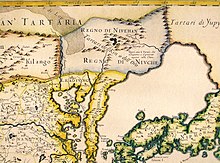
Two years later, Nurhaci announced the "Seven Grievances" and openly renounced the sovereignty of Ming overlordship in order to complete the unification of those Jurchen tribes still allied with the Ming emperor. After a series of successful battles, he relocated his capital from Hetu Ala to successively bigger captured Ming cities in Liaodong: first Liaoyang in 1621, then Mukden (Shenyang) in 1625.[34] Furthermore, the Khorchin proved a useful ally in the war, lending the Jurchens their expertise as cavalry archers. To guarantee this new alliance, Nurhaci initiated a policy of inter-marriages between the Jurchen and Khorchin nobilities, while those who resisted were met with military action. This is a typical example of Nurhaci's initiatives that eventually became official Qing government policy. During most of the Qing period, the Mongols gave military assistance to the Manchus.[35]

Hong Taiji
Nurhaci died in 1626, and was succeeded by his eighth son, Hong Taiji. Although Hong Taiji was an experienced leader and the commander of two Banners, the Jurchens suffered defeat in 1627, in part due to the Ming's newly acquired Portuguese cannons. To redress the technological and numerical disparity, Hong Taiji in 1634 created his own artillery corps, who cast their own cannons in the European design with the help of defector Chinese metallurgists. One of the defining events of Hong Taiji's reign was the official adoption of the name "Manchu" for the united Jurchen people in November 1635. In 1635, the Manchus' Mongol allies were fully incorporated into a separate Banner hierarchy under direct Manchu command. In April 1636, Mongol nobility of Inner Mongolia, Manchu nobility and the Han mandarin recommended that Hong as the khan of Later Jin should be the emperor of the Great Qing.[36][37] When he was presented with the imperial seal of the Yuan dynasty after the defeat of the last Khagan of the Mongols, Hong Taiji renamed his state from "Great Jin" to "Great Qing" and elevated his position from Khan to Emperor, suggesting imperial ambitions beyond unifying the Manchu territories. Hong Taiji then proceeded to invade Korea again in 1636.

Meanwhile, Hong Taiji set up a rudimentary bureaucratic system based on the Ming model. He established six boards or executive level ministries in 1631 to oversee finance, personnel, rites, military, punishments, and public works. However, these administrative organs had very little role initially, and it was not until the eve of completing the conquest ten years later that they fulfilled their government roles.[38]
Hong Taiji staffed his bureaucracy with many Han Chinese, including newly surrendered Ming officials, but ensured Manchu dominance by an ethnic quota for top appointments. Hong Taiji's reign also saw a fundamental change of policy towards his Han Chinese subjects. Nurhaci had treated Han in Liaodong according to how much grain they had: those with less than 5 to 7 sin were treated badly, while those with more were rewarded with property. Due to a Han revolt in 1623, Nurhaci turned against them and enacted discriminatory policies and killings against them. He ordered that Han who assimilated to the Jurchen (in Jilin) before 1619 be treated equally with Jurchens, not like the conquered Han in Liaodong. Hong Taiji recognized the need to attract Han Chinese, explaining to reluctant Manchus why he needed to treat the Ming defector General Hong Chengchou leniently.[39] Hong Taiji incorporated Han into the Jurchen "nation" as full (if not first-class) citizens, obligated to provide military service. By 1648, less than one-sixth of the bannermen were of Manchu ancestry.[40]
Claiming the Mandate of Heaven
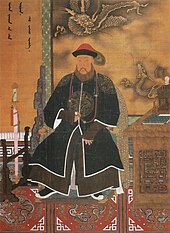
Hong Taiji died suddenly in September 1643. As the Jurchens had traditionally "elected" their leader through a council of nobles, the Qing state did not have a clear succession system. The leading contenders for power were Hong Taiji's oldest son Hooge and Hong Taiji's half brother Dorgon. A compromise installed Hong Taiji's five-year-old son, Fulin, as the Shunzhi Emperor, with Dorgon as regent and de facto leader of the Manchu nation.
Meanwhile, Ming government officials fought against each other, against fiscal collapse, and against a series of peasant rebellions. They were unable to capitalise on the Manchu succession dispute and the presence of a minor as emperor. In April 1644, the capital, Beijing, was sacked by a coalition of rebel forces led by Li Zicheng, a former minor Ming official, who established a short-lived Shun dynasty. The last Ming ruler, the Chongzhen Emperor, committed suicide when the city fell to the rebels, marking the official end of the dynasty.
Li Zicheng then led rebel forces numbering some 200,000[41] to confront Wu Sangui, at Shanhai Pass, a key pass of the Great Wall, which defended the capital. Wu Sangui, caught between a Chinese rebel army twice his size and a foreign enemy he had fought for years, cast his lot with the familiar Manchus. Wu Sangui may have been influenced by Li Zicheng's mistreatment of wealthy and cultured officials, including Li's own family; it was said that Li took Wu's concubine Chen Yuanyuan for himself. Wu and Dorgon allied in the name of avenging the death of the Chongzhen Emperor. Together, the two former enemies met and defeated Li Zicheng's rebel forces in battle on May 27, 1644.[42]
The newly allied armies captured Beijing on 6 June. The Shunzhi Emperor was invested as the "Son of Heaven" on 30 October. The Manchus, who had positioned themselves as political heirs to the Ming emperor by defeating Li Zicheng, completed the symbolic transition by holding a formal funeral for the Chongzhen Emperor. However, conquering the rest of China Proper took another seventeen years of battling Ming loyalists, pretenders and rebels. The last Ming pretender, Prince Gui, sought refuge with the King of Burma, Pindale Min, but was turned over to a Qing expeditionary army commanded by Wu Sangui, who had him brought back to Yunnan province and executed in early 1662.
The Qing had taken shrewd advantage of Ming civilian government discrimination against the military and encouraged the Ming military to defect by spreading the message that the Manchus valued their skills.[43] Banners made up of Han Chinese who defected before 1644 were classed among the Eight Banners, giving them social and legal privileges. Han defectors swelled the ranks of the Eight Banners so greatly that ethnic Manchus became a minority – only 16% in 1648, with Han Bannermen dominating at 75% and Mongol Bannermen making up the rest.[44] Gunpowder weapons like muskets and artillery were wielded by the Chinese Banners.[45] Normally, Han Chinese defector troops were deployed as the vanguard, while Manchu Bannermen were used predominantly for quick strikes with maximum impact, so as to minimize ethnic Manchu losses.[46]
This multi-ethnic force conquered Ming China for the Qing.[47] The three Liaodong Han Bannermen officers who played key roles in the conquest of southern China were Shang Kexi, Geng Zhongming, and Kong Youde, who governed southern China autonomously as viceroys for the Qing after the conquest.[48] Han Chinese Bannermen made up the majority of governors in the early Qing, stabilizing Qing rule.[49] To promote ethnic harmony, a 1648 decree allowed Han Chinese civilian men to marry Manchu women from the Banners with the permission of the Board of Revenue if they were registered daughters of officials or commoners, or with the permission of their banner company captain if they were unregistered commoners. Later in the dynasty the policies allowing intermarriage were done away with.[50]
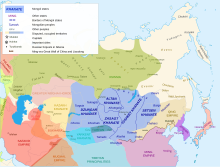
The first seven years of the young Shunzhi Emperor's reign were dominated by Dorgon's regency. Because of his own political insecurity, Dorgon followed Hong Taiji's example by ruling in the name of the emperor at the expense of rival Manchu princes, many of whom he demoted or imprisoned. Dorgon's precedents and example cast a long shadow. First, the Manchus had entered "South of the Wall" because Dorgon had responded decisively to Wu Sangui's appeal, then, instead of sacking Beijing as the rebels had done, Dorgon insisted, over the protests of other Manchu princes, on making it the dynastic capital and reappointing most Ming officials. No major Chinese dynasty had directly taken over its immediate predecessor's capital, but keeping the Ming capital and bureaucracy intact helped quickly stabilize the regime and sped up the conquest of the rest of the country. Dorgon then drastically reduced the influence of the eunuchs and directed Manchu women not to bind their feet in the Chinese style.[51]
However, not all of Dorgon's policies were equally popular or as easy to implement. The controversial July 1645 edict (the "haircutting order") forced adult Han Chinese men to shave the front of their heads and comb the remaining hair into the queue hairstyle which was worn by Manchu men, on pain of death.[52] The popular description of the order was: "To keep the hair, you lose the head; To keep your head, you cut the hair."[51] To the Manchus, this policy was a test of loyalty and an aid in distinguishing friend from foe. For the Han Chinese, however, it was a humiliating reminder of Qing authority that challenged traditional Confucian values.[53] The order triggered strong resistance in Jiangnan.[54] In the ensuing unrest, some 100,000 Han were slaughtered.[55][56][57]
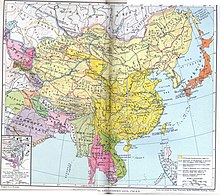
On 31 December 1650, Dorgon died suddenly, marking the start of the Shunzhi Emperor's personal rule. Because the emperor was only 12 years old at that time, most decisions were made on his behalf by his mother, Empress Dowager Xiaozhuang, who turned out to be a skilled political operator. Although his support had been essential to Shunzhi's ascent, Dorgon had centralised so much power in his hands as to become a direct threat to the throne. So much so that upon his death he was bestowed the extraordinary posthumous title of Emperor Yi (義皇帝), the only instance in Qing history in which a Manchu "prince of the blood" (親王) was so honored. Two months into Shunzhi's personal rule, however, Dorgon was not only stripped of his titles, but his corpse was disinterred and mutilated.[58] Dorgon's fall from grace also led to the purge of his family and associates at court. Shunzhi's promising start was cut short by his early death in 1661 at the age of 24 from smallpox. He was succeeded by his third son Xuanye, who reigned as the Kangxi Emperor.
The Manchus sent Han Bannermen to fight against Koxinga's Ming loyalists in Fujian.[59] They removed the population from coastal areas in order to deprive Koxinga's Ming loyalists of resources. This led to a misunderstanding that Manchus were "afraid of water". Han Bannermen carried out the fighting and killing, casting doubt on the claim that fear of the water led to the coastal evacuation and ban on maritime activities.[60] Even though a poem refers to the soldiers carrying out massacres in Fujian as "barbarians", both Han Green Standard Army and Han Bannermen were involved and carried out the worst slaughter.[61] 400,000 Green Standard Army soldiers were used against the Three Feudatories in addition to the 200,000 Bannermen.[62]
Kangxi Emperor's reign and consolidation
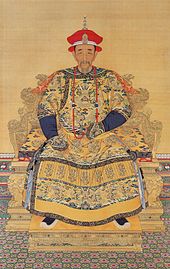
The sixty-one year reign of the Kangxi Emperor was the longest of any emperor of China and marked the beginning of the "High Qing" era, the zenith of the dynasty's social, economic and military power. The early Manchu rulers established two foundations of legitimacy that help to explain the stability of their dynasty. The first was the bureaucratic institutions and the neo-Confucian culture that they adopted from earlier dynasties.[63] Manchu rulers and Han Chinese scholar-official elites gradually came to terms with each other. The examination system offered a path for ethnic Han to become officials. Imperial patronage of Kangxi Dictionary demonstrated respect for Confucian learning, while the Sacred Edict of 1670 effectively extolled Confucian family values. His attempts to discourage Chinese women from foot binding, however, were unsuccessful.
The second major source of stability was the Inner Asian aspect of their Manchu identity, which allowed them to appeal to the Mongol, Tibetan and Muslim subjects.[64] The Qing used the title of Emperor (Huangdi or hūwangdi) in Chinese and Manchu (along with titles like the Son of Heaven and Ejen), and among Tibetans the Qing emperor was referred to as the "Emperor of China" (or "Chinese Emperor") and "the Great Emperor" (or "Great Emperor Manjushri"), such as in the 1856 Treaty of Thapathali,[65][66][67] while among Mongols the Qing monarch was referred to as Bogda Khan[68] or "(Manchu) Emperor", and among Muslim subjects in Inner Asia the Qing ruler was referred to as the "Khagan of China" (or "Chinese khagan").[69] The Qianlong Emperor portrayed the image of himself as a Buddhist sage ruler, a patron of Tibetan Buddhism[70] in the hope to appease the Mongols and Tibetans.[71] The Kangxi Emperor also welcomed to his court Jesuit missionaries, who had first come to China under the Ming.
Kangxi's reign started when he was seven years old. To prevent a repeat of Dorgon's monopolizing of power, on his deathbed his father hastily appointed four regents who were not closely related to the imperial family and had no claim to the throne. However, through chance and machination, Oboi, the most junior of the four, gradually achieved such dominance as to be a potential threat. In 1669 Kangxi, through trickery, disarmed and imprisoned Oboi – a significant victory for a fifteen-year-old emperor.
The young emperor faced challenges in maintaining control of his kingdom, as well. Three Ming generals singled out for their contributions to the establishment of the dynasty had been granted governorships in Southern China. They became increasingly autonomous, leading to the Revolt of the Three Feudatories, which lasted for eight years. Kangxi was able to unify his forces for a counterattack led by a new generation of Manchu generals. By 1681, the Qing government had established control over a ravaged southern China, which took several decades to recover.[72]
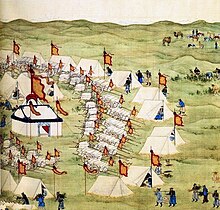
To extend and consolidate the dynasty's control in Central Asia, the Kangxi Emperor personally led a series of military campaigns against the Dzungars in Outer Mongolia. The Kangxi Emperor expelled Galdan's invading forces from these regions, which were then incorporated into the empire. Galdan was eventually killed in the Dzungar–Qing War.[73] In 1683, Qing forces received the surrender of Formosa (Taiwan) from Zheng Keshuang, grandson of Koxinga, who had conquered Taiwan from the Dutch colonists as a base against the Qing. Winning Taiwan freed Kangxi's forces for a series of battles over Albazin, the far eastern outpost of the Tsardom of Russia. The 1689 Treaty of Nerchinsk was China's first formal treaty with a European power and kept the border peaceful for the better part of two centuries. After Galdan's death, his followers, as adherents to Tibetan Buddhism, attempted to control the choice of the next Dalai Lama. Kangxi dispatched two armies to Lhasa, the capital of Tibet, and installed a Dalai Lama sympathetic to the Qing.[74]
Reigns of the Yongzheng and Qianlong emperors
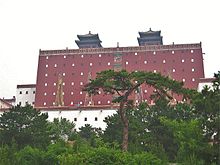
The reigns of the Yongzheng Emperor (r. 1723–1735) and his son, the Qianlong Emperor (r. 1735–1796), marked the height of Qing power. Yet, as the historian Jonathan Spence puts it, the empire by the end of the Qianlong reign was "like the sun at midday". In the midst of "many glories", he writes, "signs of decay and even collapse were becoming apparent".[75]
After the death of the Kangxi Emperor in the winter of 1722, his fourth son, Prince Yong (雍親王), became the Yongzheng Emperor. He felt a sense of urgency about the problems that had accumulated in his father's later years.[76] In the words of one recent historian, he was "severe, suspicious, and jealous, but extremely capable and resourceful",[77] and in the words of another, he turned out to be an "early modern state-maker of the first order".[78] First, he promoted Confucian orthodoxy and cracked down on unorthodox sects. In 1723 he outlawed Christianity and expelled most Christian missionaries.[79] He expanded his father's system of Palace Memorials, which brought frank and detailed reports on local conditions directly to the throne without being intercepted by the bureaucracy, and he created a small Grand Council of personal advisors, which eventually grew into the emperor's de facto cabinet for the rest of the dynasty. He shrewdly filled key positions with Manchu and Han Chinese officials who depended on his patronage. When he began to realize the extent of the financial crisis, Yongzheng rejected his father's lenient approach to local elites and enforced collection of the land tax. The increased revenues were to be used for "money to nourish honesty" among local officials and for local irrigation, schools, roads, and charity. Although these reforms were effective in the north, in the south and lower Yangzi valley there were long-established networks of officials and landowners. Yongzheng dispatched experienced Manchu commissioners to penetrate the thickets of falsified land registers and coded account books, but they were met with tricks, passivity, and even violence. The fiscal crisis persisted.[80]
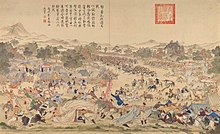
Yongzheng also inherited diplomatic and strategic problems. A team made up entirely of Manchus drew up the Treaty of Kyakhta (1727) to solidify the diplomatic understanding with Russia. In exchange for territory and trading rights, the Qing would have a free hand in dealing with the situation in Mongolia. Yongzheng then turned to that situation, where the Zunghars threatened to re-emerge, and to the southwest, where local Miao chieftains resisted Qing expansion. These campaigns drained the treasury but established the emperor's control of the military and military finance.[81]
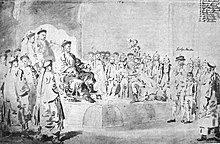
When Yongzheng Emperor died in 1735 his son Prince Bao (寶親王) became the Qianlong Emperor. Qianlong personally led the Ten Great Campaigns to expand military control into present-day Xinjiang and Mongolia, putting down revolts and uprisings in Sichuan and southern China while expanding control over Tibet. The Qianlong Emperor launched several ambitious cultural projects, including the compilation of the Complete Library of the Four Treasuries (or Siku Quanshu), the largest collection of books in Chinese history. Nevertheless, Qianlong used the literary inquisition to silence opposition.[82] Beneath outward prosperity and imperial confidence, the later years of Qianlong's reign were marked by rampant corruption and neglect. Heshen, the emperor's handsome young favorite, took advantage of the emperor's indulgence to become one of the most corrupt officials in the history of the dynasty.[83] Qianlong's son, the Jiaqing Emperor (r. 1796–1820), eventually forced Heshen to commit suicide.

Population was stagnant for the first half of the 17th century due to civil wars and epidemics, but prosperity and internal stability gradually reversed this trend. The Qianlong Emperor bemoaned the situation by remarking, "The population continues to grow, but the land does not." The introduction of new crops from the Americas such as the potato and peanut allowed an improved food supply as well, so that the total population of China during the 18th century ballooned from 100 million to 300 million people. Soon farmers were forced to work ever-smaller holdings more intensely. The only remaining part of the empire that had arable farmland was Manchuria, where the provinces of Jilin and Heilongjiang had been walled off as a Manchu homeland. Despite prohibitions, by the 18th century Han Chinese streamed into Manchuria, both illegally and legally, over the Great Wall and Willow Palisade.
In 1796, open rebellion broke out among followers of the White Lotus Society, who blamed Qing officials, saying "the officials have forced the people to rebel." Officials in other parts of the country were also blamed for corruption, failing to keep the famine relief granaries full, poor maintenance of roads and waterworks, and bureaucratic factionalism. There soon followed uprisings of "new sect" Muslims against local Muslim officials, and Miao tribesmen in southwest China. The White Lotus Rebellion continued for eight years, until 1804, when badly run, corrupt, and brutal campaigns finally ended it.[84]
Rebellion, unrest, and external pressure

At the start of the dynasty, the Chinese empire continued to be the hegemonic power in East Asia. Although there was no formal ministry of foreign relations, the Lifan Yuan was responsible for relations with the Mongol and Tibetans in Central Asia, while the tributary system, a loose set of institutions and customs taken over from the Ming, in theory governed relations with East and Southeast Asian countries. The Treaty of Nerchinsk, signed in 1689, stabilized relations with Tsarist Russia.
However, during the 18th century European empires gradually expanded across the world, as European states developed economies built on maritime trade, colonial extraction, and advances in technology. The dynasty was confronted with newly developing concepts of the international system and state-to-state relations. European trading posts expanded into territorial control in nearby India and on the islands that are now Indonesia. The Qing response, successful for a time, was to establish the Canton System in 1756, which restricted maritime trade to that city (present-day Guangzhou) and gave monopoly trading rights to private Chinese merchants. The British East India Company and the Dutch East India Company had long before been granted similar monopoly rights by their governments.
In 1793, the British East India Company, with the support of the British government, sent a diplomatic mission to China led by Lord George Macartney in order to open trade and put relations on a basis of equality. The imperial court viewed trade as of secondary interest, whereas the British saw maritime trade as the key to their economy. The Qianlong Emperor told Macartney "the kings of the myriad nations come by land and sea with all sorts of precious things", and "consequently there is nothing we lack..."[85]
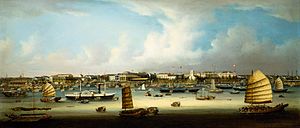
Since China had little demand for European goods, Europe paid in silver for Chinese goods, an imbalance that worried the mercantilist governments of Britain and France. The growing Chinese demand for opium provided the remedy. The British East India Company greatly expanded its production in Bengal. The Daoguang Emperor, concerned both over the outflow of silver and the damage that opium smoking was causing to his subjects, ordered Lin Zexu to end the opium trade. Lin confiscated the stocks of opium without compensation in 1839, leading Britain to send a military expedition the following year. The First Opium War revealed the outdated state of the Chinese military. The Qing navy, composed entirely of wooden sailing junks, was severely outclassed by the modern tactics and firepower of the British Royal Navy. British soldiers, using advanced muskets and artillery, easily outmaneuvered and outgunned Qing forces in ground battles. The Qing surrender in 1842 marked a decisive, humiliating blow. The Treaty of Nanjing, the first of the "unequal treaties", demanded war reparations, forced China to open up the Treaty Ports of Canton, Amoy, Fuzhou, Ningbo and Shanghai to Western trade and missionaries, and to cede Hong Kong Island to Britain. It revealed weaknesses in the Qing government and provoked rebellions against the regime.
The Taiping Rebellion in the mid-19th century was the first major instance of anti-Manchu sentiment. The rebellion began under the leadership of Hong Xiuquan (1814–64), a disappointed civil service examination candidate who, influenced by Christian teachings, had a series of visions and believed himself to be the son of God, the younger brother of Jesus Christ, sent to reform China. A friend of Hong's, Feng Yunshan, utilized Hong's ideas to organize a new religious group, the God Worshippers' Society (Bai Shangdi Hui), which he formed among the impoverished peasants of Guangxi province.[86] Amid widespread social unrest and worsening famine, the rebellion not only posed the most serious threat towards Qing rulers, it has also been called the "bloodiest civil war of all time"; during its fourteen-year course from 1850 to 1864 between 20 and 30 million people died.[87] Hong Xiuquan, a failed civil service candidate, in 1851 launched an uprising in Guizhou province, and established the Taiping Heavenly Kingdom with Hong himself as king. Hong announced that he had visions of God and that he was the brother of Jesus Christ. Slavery, concubinage, arranged marriage, opium smoking, footbinding, judicial torture, and the worship of idols were all banned. However, success led to internal feuds, defections and corruption. In addition, British and French troops, equipped with modern weapons, had come to the assistance of the Qing imperial army. Nonetheless, it was not until 1864 that Qing armies under Zeng Guofan succeeded in crushing the revolt. After the outbreak of this rebellion, there were also revolts by the Muslims and Miao people of China against the Qing dynasty, most notably in the Miao Rebellion (1854–1873) in Guizhou, the Panthay Rebellion (1856–1873) in Yunnan and the Dungan Revolt (1862–1877) in the northwest.
Zdroj:https://en.wikipedia.org?pojem=Great_Qing_Empire
Text je dostupný za podmienok Creative Commons Attribution/Share-Alike License 3.0 Unported; prípadne za ďalších podmienok. Podrobnejšie informácie nájdete na stránke Podmienky použitia.
Antropológia
Aplikované vedy
Bibliometria
Dejiny vedy
Encyklopédie
Filozofia vedy
Forenzné vedy
Humanitné vedy
Knižničná veda
Kryogenika
Kryptológia
Kulturológia
Literárna veda
Medzidisciplinárne oblasti
Metódy kvantitatívnej analýzy
Metavedy
Metodika
Text je dostupný za podmienok Creative
Commons Attribution/Share-Alike License 3.0 Unported; prípadne za ďalších
podmienok.
Podrobnejšie informácie nájdete na stránke Podmienky
použitia.
www.astronomia.sk | www.biologia.sk | www.botanika.sk | www.dejiny.sk | www.economy.sk | www.elektrotechnika.sk | www.estetika.sk | www.farmakologia.sk | www.filozofia.sk | Fyzika | www.futurologia.sk | www.genetika.sk | www.chemia.sk | www.lingvistika.sk | www.politologia.sk | www.psychologia.sk | www.sexuologia.sk | www.sociologia.sk | www.veda.sk I www.zoologia.sk

